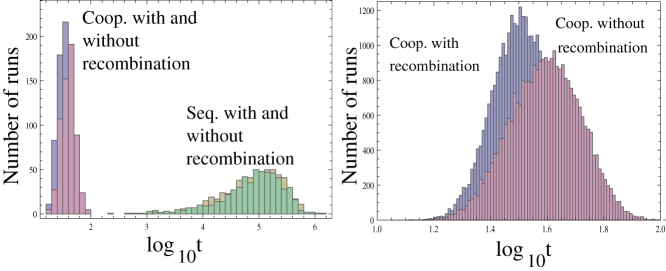Figure 6. Effect of recombination.
The simulations of Figure 2a were re-run assuming that recombination can occur. This was done by assuming that per time step, there is a probability Rec1 that a “donor” agent meets a “recipient” agent within the reproduction radius. When they do meet, then there is a probability Rec2 for each locus in the recipient to be exchanged with the genotype of the donor. The histograms in (a) present the times until the m-hit mutant reached 90% of the total population under 4 scenarios: cooperation/cheating and sequential evolution, with and without recombination (600 runs per scenario). We observe that sequential evolution takes a lot longer to create m-hit mutants compared to the cooperation/cheating scenario, regardless of the presence of recombination. Panel (b) presents a more detailed picture of the cooperation/cheating scenario (30,000 runs per scenario) and shows that the generation of an m-hit mutant is accelerated in the presence of recombination (the mean times are 33.1 and 41.2, which are significantly different with p<10−10). Recombination introduces no statistically significant difference in the case of sequential evolution. Parameters are the same as in Figure 2a, and in addition, Rec1 = 0.1 and Rec2 = 0.01.

